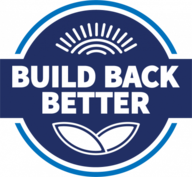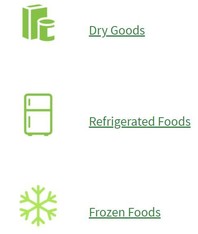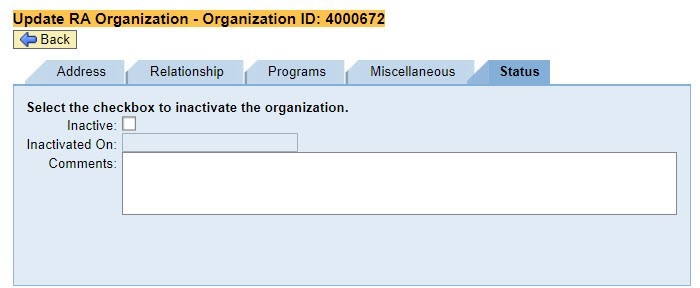
Build Back Better Initiative
On June 4, USDA announced an investment of $1 billion to purchase healthy food for the emergency food network and focus on rebuilding a better U.S. food system. This initiative will help build capacity and provide additional support to State emergency food networks, food banks and local organizations to serve their communities. These funds will support and expand access to nutrition assistance and improve food purchase and distribution channels through the following:
- $500 million to purchase food and provide administrative funds to The Emergency Food Assistance Program (TEFAP);
- Up to $400 million for cooperative agreements to States and Tribal governments, or other local partners, to purchase food from local, regional and socially disadvantaged producers; and
- $100 million to administer infrastructure grants to help food banks and other local organizations build capacity and expand their reach.
USDA will work with State and Tribal partners to provide resources through this initiative. Local programs interested in distributing USDA Foods to their communities should contact their TEFAP State agency for more information. USDA will continue to provide information about food purchases, cooperative agreements, and grant opportunities as this initiative is rolled out in the coming months.
|

CSFP Milk Shortage
CSFP is experiencing low milk inventory due to vendor capacity constraints caused by increased demand in the commercial market. FNS published a memorandum titled “Commodity Supplemental Food Program: Guidance on Temporary Shortage of Ultra-High Temperature Fluid Milk” on March 19th, 2021, providing information on the shortage and directing States on how to adjust milk issuances in response. In light of the shortage, FNS is temporarily limiting milk category distribution to one ultra-high temperature (UHT) milk and one non-fat dry milk (NFDM). FNS will lift this limitation once vendor capacities return to normal levels. Should shortfalls still arise, State agencies must obtain FNS approval to distribute incomplete food packages.
|

Frozen Peach Slices
The options are endless for frozen peach slices! Frozen peach slices were recently added to the TEFAP Foods Available List and are packed in a two pound bag that can be easily stored in the freezer. Peaches contain vitamin C as well as other nutrients such as potassium, fiber, and iron. Since peaches are naturally high in sugar, they can be eaten in place of desserts that we should consume less often, like cakes, cookies, and sweet breads. Peaches are versatile and can be incorporated into meals and snacks – from breakfast, to entrees, to healthy desserts, or they can be eaten on their own. Use them at breakfast in a fruit and vegetable smoothie, add some to a bowl of low-fat yogurt, or on top of cereal and milk. For lunch or dinner, consider a light summer salad with mixed greens or spinach, dry roasted, crumbled peanuts, peaches, canned chicken or salmon, and a splash of oil and vinegar. Frozen peaches can be crushed and added to iced tea or sparkling water. Peaches are also a great addition to desserts and help cut down on added sugar. Check out this Peach Crisp recipe that uses several foods available through TEFAP, including rolled oats, flour, and peaches. Use whole wheat or white whole wheat flour to boost your whole grains. Need a few more peach recipes for all eating occasions? Check out dozens of recipes that include peaches from the SNAP Recipes at MyPlate Kitchen. Also, don’t forget to check out the frozen peaches Household USDA Foods Product Information Sheet – there is an information sheet for all USDA Foods available through TEFAP!
|

Nutrition Education in CSFP
The Commodity Supplemental Food Program (CSFP) Sharing Gallery is a collection of resources and materials to assist state and local agencies in providing food and nutrition information to program participants. The CSFP Sharing Gallery has a new look for Summer 2021! The resources have been refreshed and are organized by format type. Check out the CSFP Sharing Gallery and get inspired today! If you have any questions about where to find a particular resource or how to best utilize the resources included in the sharing gallery, please reach out to us at USDAFoods@usda.gov.
Interested in contributing content to the CSFP Sharing Gallery? Send your handouts, recipes, cookbooks, lessons, and other resources that meet the criteria to USDAFoods@usda.gov Please review our Sharing Gallery Criteria and Recipe Criteria for submitting materials and recipes.
|

Best Practices for Handling and Storing USDA Foods at Home
USDA has three new resources to provide households with basic information on how to safely handle and store USDA Foods received from The Emergency Food Assistance Program (TEFAP), the Commodity Supplemental Food Assistance Program (CSFP), and the Food Distribution Program on Indian Reservations (FDPIR).
While these resources were created to provide general guidance on how to maximize shelf life and ensure the safe handling of the various types of USDA Foods, including dry goods, refrigerated foods, and frozen foods, the best practices included on these handouts apply to foods from any source.
Check out this new resource: Best Practices to Safely Handle and Store USDA Foods at Home.
|

CSFP Additional Caseload for American Rescue Plan and Administrative Grants
On March 11, 2021, President Biden signed the American Rescue Plan Act of 2021, which provided an additional $37 million in funding for the Commodity Supplemental Food Program (CSFP), bringing CSFP’s total full year 2021 funding level to $375 million. This funding increase allowed for an increase to the national CSFP caseload level by 24,524 slots to 760,634. FNS is now able to both meet all unmet 2021 additional caseload requests from currently participating CSFP State agencies and to add the Wichita and Affiliated Tribes to the program. FNS released the memorandum titled “Commodity Supplemental Food Program (CSFP): Additional Caseload Assignments for the 2021 Caseload Cycle,” which contains the full details of the additional caseload.
On April 23, 2021, FNS released the additional allocation of CSFP administrative funds based on the mandatory grant per assigned caseload slot for fiscal year 2021, which is $82.43. These funds must be reported separately from regular CSFP administrative funding.
|
Receipting Multiple Shipments in WBSCM
In Web-Based Supply Chain Management (WBSCM), when a vendor ships an order in multiple parts with more than one Advance Shipping Notice (ASN), the order appears as multiple rows in the receipting screen. To help users select the correct row to enter receipt information, the ASN Number column has been added to the default view (eINV_VIEW). Users may also refer to the BOL# column to confirm that the correct row is selected.

Annual User Validation
USDA conducts an annual user validation and cleanup for WBSCM. All current users will receive instructions by email to ensure they retain access (if needed).
To continue their access to WBSCM, all users are encouraged to log in to their profile(s) periodically throughout the year. During the annual validation, User Administrators review user profiles for their respective organizations and lock user profiles after 9 months of inactivity and delete them after 12 months of inactivity.
Inactive Organizations
With the April release, WBSCM now allows Organization Administrators to inactivate sub-organizations, as needed. For example, a State Distributing Agency (SDA) can change the status of their Recipient Agencies (RAs) to inactive if they are no longer participating in programs. Inactive organizations cannot be selected for new transactions; however, they will continue to appear on existing transactions and in reports. For some administrative functions, users can switch between the lists of “active” and “inactive” users.
WBSCM will automatically record the date an organization was changed to inactive, and the Organization Admin can enter comments to document the reason. If needed, inactive organizations can be reactivated.

WBSCM Resources
WBSCM is under continuous improvement through monthly development activities, and help resources are regularly updated to reflect the latest system changes and recommended processes. Available resource types include work instructions, job aids, simulations, course materials, and release notes.
To access the document library from WBSCM, navigate to Help → Training; then drill down through the categories, user groups, and functional areas or topics. These resources can also be accessed via on-screen help while performing most WBSCM transactions by clicking the Options button and selecting Help.
 For questions about WBSCM, please contact the WBSCM Service Desk or call (877) 927-2648.
System Reminders
- 6/25/2021 – WBSCM Enhancement/Maintenance Release 2021.R4.2.06
- 7/10/2021 – FFAVORS 3.2 Release
- 7/29/2021 – WBSCM Maintenance Release 2021.R4.2.07
Planned dates for system activities are subject to change.
|